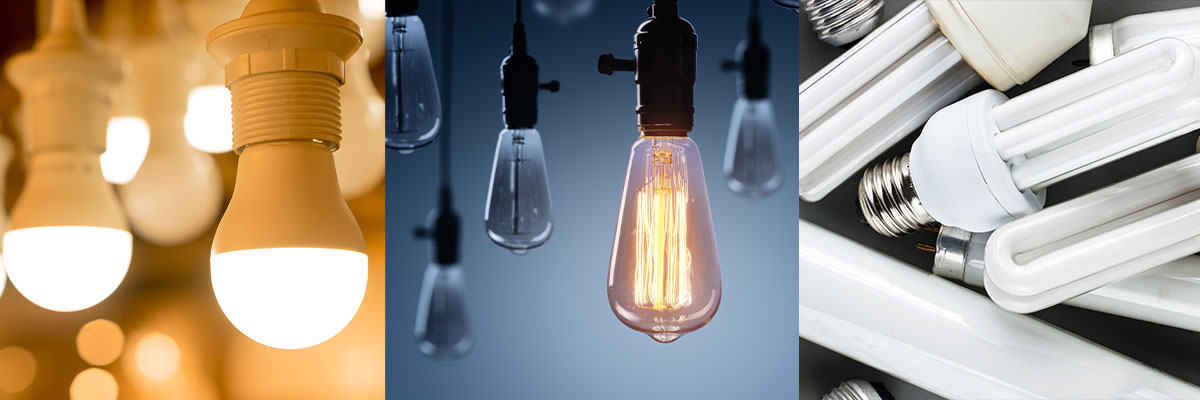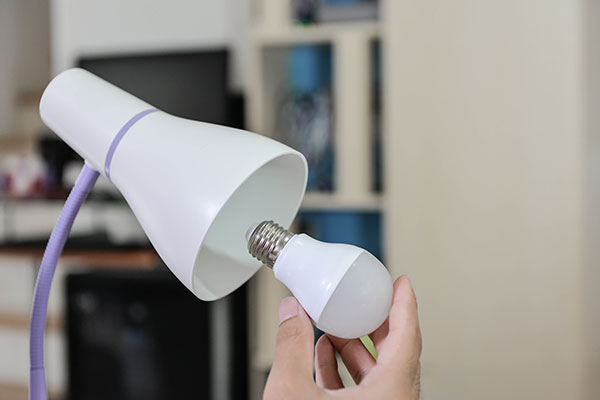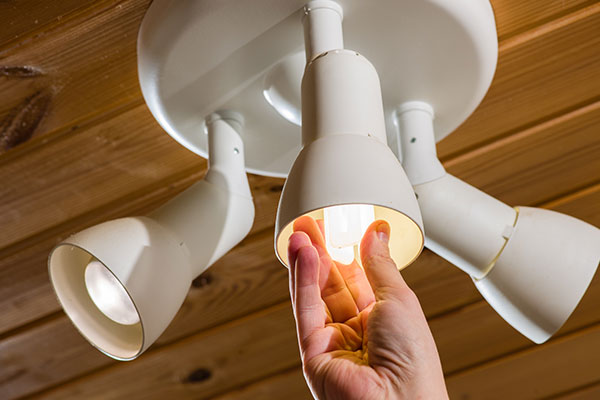

Light Bulb Types: How Do You Choose?
Light bulbs are a household essential. You’d think buying them would be simple! But, it’s easy to get overwhelmed by the large number of different light bulbs available. How do you choose the light bulb type that's right for you?
Types of Light Bulbs
While there are many different types of light bulbs, the most common household bulb types are LED, incandescent, halogen and CFL. We’re going to break down these different types and how they might be used in your home.

LED Light Bulbs
Light-Emitting Diode or LED light bulbs are the most energy-efficient light bulbs and have become very common. When they first came out, LED lights had a reputation for being expensive. With advances in manufacturing, prices have reduced significantly. Since they use less energy and last longer than other bulb types, their long-term cost is lower. Additionally, LED light bulbs have less environmental impact than incandescent bulbs. LED light bulbs don’t release much heat when they are on, making them a safer option for holiday decorations, in nurseries or in lamps accessible by children.
Incandescent Light Bulbs
Incandescent light bulbs are the most well-known light bulbs, having been around since the 19th century. They have a lower up-front cost, but they don’t last quite as long as LEDs or CFLs. They release up to 90% of their energy as heat, so they tend to get hot. Avoid using them around flammable material or in areas where children can reach them. While incandescent bulbs may not be the most energy-efficient, they are widely available and affordable. They are often the only choice for specialty use like in appliances or chandeliers.
New rules by the U.S. Energy Department will no longer allow the sale of incandescent light bulbs lower than 45 watts in 2023. This was done in an effort to shift consumers away from inefficient light bulbs to more sustainable and ultimately affordable options like LEDs.
Halogen Light Bulbs
Halogen light bulbs are a type of incandescent light bulb that uses halogen gas and tungsten vapor to create a brighter light than typical incandescent bulbs. They are most often used in security lights, flood lights and spotlights. Like regular incandescent light bulbs, halogen lights can get very hot, so it’s best to use these bulbs only in areas that are not accessible to children, pets, or around flammable objects.
Compact Florescent Light Bulbs
Compact Florescent or CFL light bulbs are a great energy-efficient bulb for areas needing a large amount of light. They are slightly more affordable than LED lights and have a long lifespan. CFL bulbs provide broad coverage, but the brightness may vary based on the age of the bulb and the conditions around them. These bulbs perform best in areas where they aren’t turned off and on frequently, like a garage. Being repeatedly turned off and on causes these bulbs to burn out more quickly. One thing to note: CFL bulbs contain a small amount of mercury, so it’s important to dispose of them properly. Your local waste management agency can instruct you on places where they can be disposed of or recycled.
Watts vs. Lumens
A watt measures how much energy a light bulb consumes, so a 60-watt light bulb consumes more electricity than a 40-watt bulb. One common misconception about watts is that they determine how bright the light emitted will be. With incandescent bulbs that is accurate. For example, a 100-watt light bulb is much brighter than a 60-watt bulb. However, that doesn’t hold true for all types. More energy-efficient bulbs, like CFLs for example, use less energy to emit a large quantity of light. So, they may be a lower wattage and still emit a bright light.
The brightness of a light bulb, or how much energy it gives off, is measured by lumens, while the warmth or coolness (the amount of yellow and blue light emitted) is listed in degrees Kelvin (K). Bulbs with fewer degrees Kelvin give off more yellow light, giving their light a cozy, soft feel. You'd want to use these in areas of your home you like to relax in, like a bedroom or living room. Bulbs with higher degrees Kelvin produce more of a blue or bright light, similar to daylight. It's best to use them in areas that need to be brightly lit, like a bathroom, kitchen or in reading lamps.
How Long Will My Light Bulb Last?
How long a light bulb lasts depends on several factors: the light bulb you chose, the lighting fixture you have, how long it’s turned on each day, and the conditions of the area it’s housed in. Light bulbs tend to last longer in areas with low humidity that don’t have many temperature changes. Because of this, indoor lights typically last longer than outdoor lights.
LED lights can last for up to 50,000 hours, meaning a light bulb used for 12 hours a day can last 11 years or more! CFL light bulbs are the next longest-lasting bulb with a lifespan of up to 10,000 hours. Incandescent and halogen bulbs usually last about 1,000 hours.

Replacing Light Bulbs
There are four factors to consider when replacing an existing light bulb to ensure you’re getting a good value that safely provides the light you need.
Light Fixture Wattage
It’s important to use the same size replacement bulb that is stated on your light fixture, because fixtures have a maximum rating of an acceptable wattage. If you’re replacing an incandescent light bulb with an LED light bulb, make sure you choose a bulb with an equivalent wattage. The wattage equivalents can be found on the LED light bulb box. A bulb may only use 10.5 watts, but the box will indicate it’s equivalent to a 60W incandescent light bulb.
Shape
Light bulbs come in many shapes. The shape of the lightbulb can vary from arbitrary (what a typical light bulb looks like) to candle shaped bulbs. Globe light bulbs are round like a ball and reflector bulbs have a metallic lining on them.
Base Type
An important part of picking out a light bulb is choosing the right size and type of base. Most light bulbs use a screw-in base. A-19 is the base size found in most household light bulbs. Recessed lights and flood lights commonly use a r-2-/br-30 base which is slightly larger than a typical light bulb base. Another common base used is a twist-and-lock base, which looks like two prongs on the bottom of the bulb. If you need help determining which base you need on your bulb, you can check your light fixture or bring the old bulb to your local McCoy’s and we can help you find the correct replacement.
Style
Light bulbs can help set the aesthetic of a room. Vintage style bulbs, commonly called Edison bulbs, have become very popular for creating a warm, inviting ambiance. They have multiple filaments (the part of the bulb that emits light) inside their housing and typically give off a warm yellow light. The filaments can be straight or spiraled and add a modern-industrial look. Because they tend to be a bit dimmer than other bulbs, they are best used in lamps and pendants instead of main light fixtures. Most people associate vintage light bulbs with incandescent lighting, but they are more commonly available in LED.
Dimming Light Bulbs
If your light bulb is currently connected to a dimming switch, make sure your new light bulb is compatible with a dimmer. Most incandescent and halogen light bulbs can work with dimmers, but only certain LED light bulbs are dimmable.
Selecting the right bulb for the task not only makes your life easier—no more squinting to read labels in the kitchen or bathroom—it also makes your home safer and more inviting. If you’re still unsure about what to choose, head to your local McCoy’s and we can help you find the perfect bulb for every need. Keep any eye out for any sales on lighting from small bulbs to security lighting.

